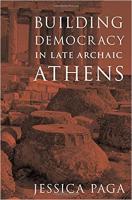
OUP (2021) h/b 360pp £47.99 (ISBN 9780190083571)
At the beginning of her invigorating study P. quotes Ernst Badian’s observation that ‘practically no facts [are] known’ about Athens between Cleisthenes’ reforms of 508/7 BC and 480/79 BC when the Persians torched the city, a crucial period in both the city’s history and its development of democracy. ‘Where the literary sources are lacking, however,’ as P. is quick to point out, ‘we have the archaeological record’, and in her hands what that record shows is nothing short of extraordinary.
After setting out the historical background, she examines in detail how an Athenian Late Archaic building programme (a term she defends robustly) transformed the environment of the Acropolis, the Agora, the astu (or city) of Athens, and wider Attica, reflecting and facilitating the political institutions of the new regime, while accentuating its distinctive identity. Determined to draw a line under the old Peisistratid regime and Spartan interventions, buoyed by spectacular military victories in 506/5 BC, and bolstered economically by the resultant booty and ransoms (not to mention revenues from silver mines at Laurium), Athenians demolished and rebuilt some sacred buildings (such as the Temple of Athena Polias or the Eleusinian Telesterion), which they perhaps deemed to have been polluted, and deliberately left the ambitious Temple of Olympian Zeus unfinished as a memorial to tyrannical hubris.
At the same time, they repurposed existing spaces, relocating the Agora to the north side of the Acropolis, reshaping and repurposing the slopes of Pnyx Hill to accommodate their Ekklesia (Assembly), a monumental undertaking, and choosing what may have been the site of the former tyrants’ palace for their new (but confusingly today called ‘Old’) Bouleuterion (Council Chamber), a revolutionary construction, perhaps the earliest hypostyle hall in Greece, and the first secular building to use the Doric order.
In wider Attica, too, where new roads facilitated travel and communication, the importance of new network of demes is evidenced in new theatral areas at Thorikos, Rhamnous and Ikaria, which doubled up as places of local assembly, while a string of new or refashioned coastal temples not only defined boundaries but presented an impressive front to foreign visitors. That no less than 45 monumental buildings were constructed during this period—most between 500 BC and 480 BC—is evidence, writes P., of the democratic regime’s ‘administrative organization, military flourishing, robust economy, and increased profile in domestic and foreign affairs.’
P.’s goal is to discover ‘how reflection on and analysis of the built environment can help shed light on this murky period of Athenian history’. She succeeds brilliantly, producing a tautly argued yet eminently readable account, which transcends the confines of the immediate subject matter to address vital questions about the workings of the Athenian proto-democracy itself. While this reviewer would have appreciated more labelling on maps and diagrams to clarify the content of the text, this handsome book is well served with maps, plans and copious illustrations (including 12 colour plates) as well as three useful appendices (a chronology of the buildings discussed; consideration of the Hekatompedon Decree; discussion of the dating of the Old Bouleuterion and Stoa Basileios), a comprehensive bibliography and index. Both as a much-needed study of a little known but vital period in the emergence of democracy and as a paradigm of how a sensitive, intelligent use of archaeology can help shed light on history, this outstanding volume cannot be recommended too enthusiastically.
David Stuttard
